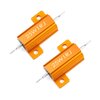Hello.... first time posting... and need some help....
I need to reduce 14v dc to 12v dc.
I have 48w LED that draws 4.5 amps at 12v. If powered at 14v, the amp draw increases to around 7 to 8 amps. LED is fine when powered with the 12v, but is greatly over heating at 14v.
In searching internet for solution to reducing the 14v to 12v, I came across similar issue where there was a need to reduce 15v to 12v and the suggested solution was the use of a 0.6R 25w resistor.
Will the above work or should the 0.6R resistor be a different value since I am working with 14v and not 15v....??
I have found 0.6R resistors with 50w and 100w ratings, but have not purchased to try them.
Any help and comments will be much appreciated.
I need to reduce 14v dc to 12v dc.
I have 48w LED that draws 4.5 amps at 12v. If powered at 14v, the amp draw increases to around 7 to 8 amps. LED is fine when powered with the 12v, but is greatly over heating at 14v.
In searching internet for solution to reducing the 14v to 12v, I came across similar issue where there was a need to reduce 15v to 12v and the suggested solution was the use of a 0.6R 25w resistor.
Will the above work or should the 0.6R resistor be a different value since I am working with 14v and not 15v....??
I have found 0.6R resistors with 50w and 100w ratings, but have not purchased to try them.
Any help and comments will be much appreciated.




